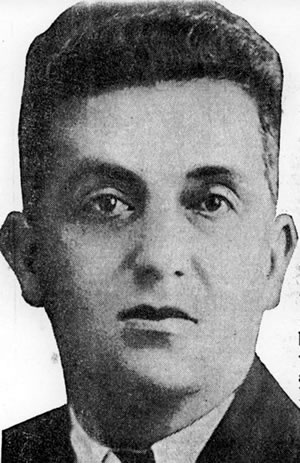
Newspaper clipping showing Dr Louis Potaka at the time he left to join Byrd's second Antarctic expedition, 1934.
Louis Potaka
New Zealander Louis Potaka, the fifth Māori medical graduate in New Zealand, served in Richard Byrd's second Antarctic expedition (BAE2) as a doctor for 12 months.
Early life in New Zealand
Louis Hauiti Potaka was born in Whanganui in March 1901, son of Welsh-born Esther Potaka (nee Caselberg) and Arapeta Tapui Potaka of Ngāti Hauiti. He was educated at Utiku Public School and Wanganui Collegiate. His father died in July 1919 and early the following year Potaka left to study at Otago Medical School. He completed his studies in 1929, serving his internship as acting house surgeon at Nelson Public Hospital. When he graduated MB ChB in 1930 he became the fifth Māori medical graduate in New Zealand.
In April 1930 he was offered a position as Medical Officer at Murchison for a three-year term. He was reportedly popular among the local people, but following conflict with the Murchison County Council he was not reappointed. He returned to Nelson Public Hospital as a temporary house surgeon in September 1933. He continued to work there until selected as doctor to Byrd's second Antarctic expedition.
No objections
One of the telegrams between Byrd and those assisting him to find a replacement doctor in New Zealand asked whether the fact that Potaka was ‘one third Maori in blood’ would disqualify him. Byrd responded: WILLING TO PAY THE MAORI 350 POUNDS STOP HE LOOKS LIKE THE BEST HAVE NO OBJECTIONS TO HIS BEING ONE THIRD MAORI STOP HE HAD BETTER BRING INSTRUMENTS
Experiences in Antarctica
Byrd had learnt in early February 1934 that the expedition's original doctor, Dr Guy Shirey, had blood pressure problems and would not be able to winter over in the Antarctic. He needed to find a replacement urgently or face having to cancel the expedition. Advertisements were placed in the New Zealand press and Potaka was one of the doctors to respond. He had some experience and set his fee 'low enough to give himself a realistic chance of being recruited'. Byrd agreed that Potaka was the best candidate. He was selected and within a few days left on the British research ship Discovery II, which happened to be in Auckland. It rendezvoused with one of the expedition's vessels, Bear of Oakland, further south and Potaka was transferred on board for the remainder of the journey to Antarctica.
Potaka arrived in Antarctica on 26 February 1934. Within weeks he performed an emergency appendectomy on cameraman Joseph Pelter, probably saving his life. But aside from another incident in August, in which an expedition member fractured his arm in an auto-giro crash, much of Potaka's time in Antarctica was uneventful. He performed monthly medical examinations on the wintering team and dealt with problems such as frostbite and the extraction of teeth. On his return to New Zealand in February 1935 he remarked that he had enjoyed his experience but was glad to be back.
Life back in New Zealand
By June 1935 Potaka had returned to Nelson to take up a position in Takaka as Dr Edward Coventry Bydder's locum and Native Medical Officer. The arrangement did not last. Potaka came into conflict with the matron to whom Bydder had left power of attorney. On hearing of problems with his practice, Bydder returned from the United Kingdom and terminated his arrangement with Potaka. But, with support from people in the local community, Potaka chose to stay on in Takaka and in March 1936 started his own practice. Bydder in turn reported him to the Nelson Division of the British Medical Association (BMA). This called him to account for his actions - such behaviour by a locum was considered unethical. In June 1936 he was instructed to close down his practice. He refused. The matter was still being discussed when Potaka took his own life on 2 October 1936. In the days leading up to his suicide Potaka was said to have been worried about his problems with Bydder. But he also left a note in which he referred to the effects of a serious eye injury he had suffered while in the Antarctic. He noted that he had not slept well since January 1935 and that death would be a relief.
Following a large funeral on 6 October, Potaka was buried at Rototai Cemetery in Golden Bay. In the weeks and months that followed his mother received many letters of condolence, including one from Byrd, expressing his deepest sympathy. Two years later she was presented with the US Congressional Medal awarded to Potaka in appreciation of his great work on the Byrd expedition. She gave the medal to Wanganui Collegiate.
The US Advisory Committee on Antarctic Names has named a long ice-filled inlet after Potaka. Potaka Inlet indents the north side of Thurston Island, the third largest island off Antarctica.
Further information
Book
- M.L. Paine (ed.), Footsteps on the ice: the Antarctic diaries of Stuart D. Paine, Second Byrd Expedition, University of Missouri Press, Missouri, 2007
Links
- Dr Louis Hauiti Potaka of New Zealand: a biographical essay (pdf) (The Knowledge Bank at Ohio State University)
- With Admiral Byrd's Second Antarctic Expedition: Bob Young's narrative account (pdf) (The Knowledge Base at Ohio State University)
- Antarctic Appendectomy (Time Magazine)
- Antarctica Service Medal (Wikipedia)



Community contributions